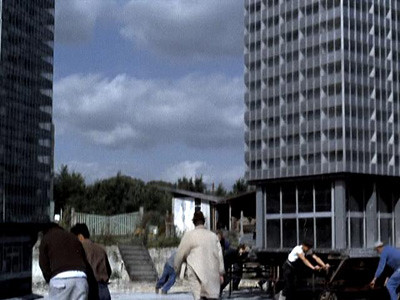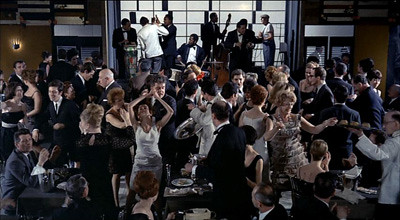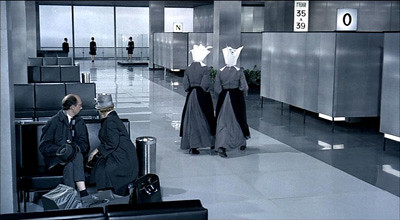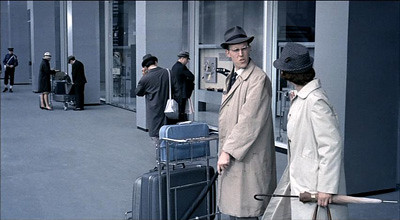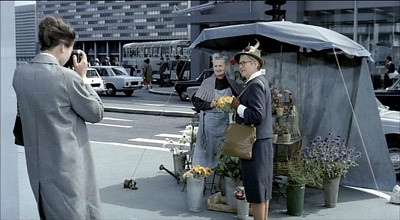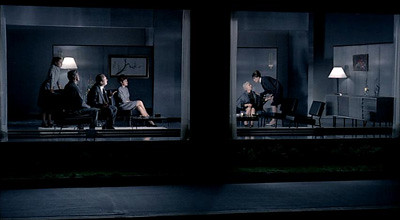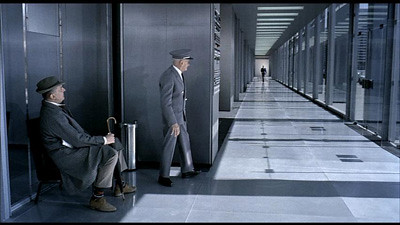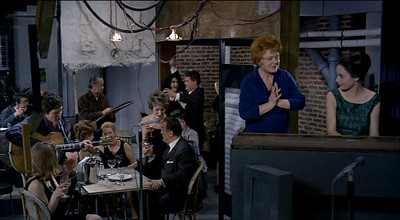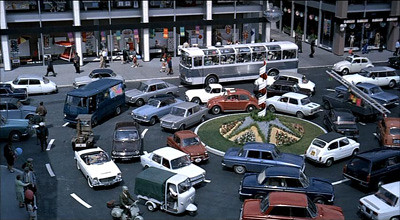If you didn't see it elsewhere, you might enjoy this piece I wrote for Slate about Edward Ford.
Saturday, December 01, 2012
#114: My Man Godfrey
My Man Godfrey, 1936, directed by Gregory La Cava, screenplay by Morrie Ryskind & Eric Hatch from the novel by Eric Hatch.
I'm told by people who've seen them projected that nitrate prints had a sparkling, shimmering quality that safety stock was never able to reproduce. If I had access to nitrate prints (and a brave projectionist), the first film I'd like to see in its original splendor is, without a doubt, Swing Time. And then Trouble In Paradise and The Thin Man and Top Hat. But somewhere around day three, provided the theater hadn't burned down, I'd send out for champagne and Gregory La Cava's My Man Godfrey, a film that was clearly designed to sparkle and shimmer. You know what you're getting right from the opening titles:

Those lights promise the kind of art deco wonderland where Rogers and Astaire spend most of their time. And La Cava delivers, but not right away. The camera pans over the waterfront, past the lights of the credits, before settling on decidedly less glamorous surroundings: a Hooverville built on top of a dump.
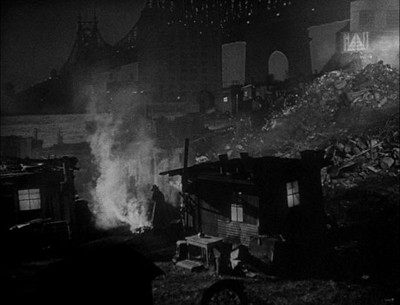
The settlement's sole inhabitant of note is none other than a bum named Godfrey, played by William Powell. He looks a lot like Nick Charles, by which I mean he looks like someone who drinks as much as Nick Charles but is not in The Thin Man.
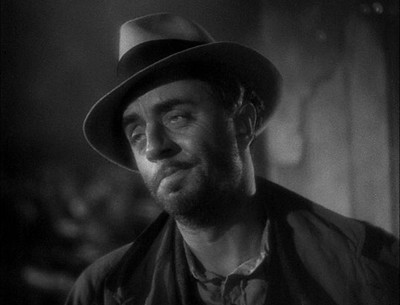
The glamor the credits promised arrives at the dump in the form of Cornelia and Irene, the Bullock sisters. They're the sort of oblivious-to-suffering rich person who I didn't think existed in real life until I read twitter during a hurricane. Cornelia, the eldest daughter (Gail Patrick), offers Godfrey five dollars to accompany her to the ballroom of the "Waldorf Ritz Hotel." It's not exactly a proposition: she's competing in a gala scavenger hunt where one of the items is a "forgotten man" (in Roosevelt's sense, not Sumner's). Godfrey's response, as he backs Cornelia into an ash pile, is for the ages: "I'm afraid I'll have to take it up with my board of directors. No matter what my board of directors advise, I think you should be spanked." No one but William Powell could pull that line off, and his delivery (and the ash pile) is striking enough to get little sister Irene (Carole Lombard) to quit freaking out about her sister beating her in the scavenger hunt and start enjoying her sister's humiliation. Which, in turn, intrigues Godfrey enough that he agrees to go to the hotel with Irene, and we're off to the art-deco races.
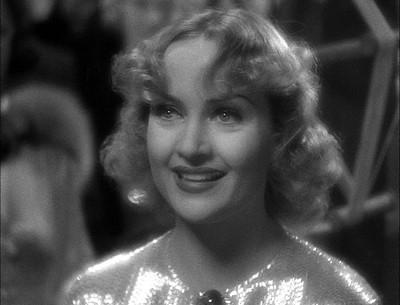
The rest of the Bullock family is even better than Gail Patrick and Carole Lombard. Eugene Pallette is as wonderful always as the beleaguered patriarch. And Alice Brady, the oblivious mother, is nearly as daffy as Lombard. We first meet her. sweeping into the hotel ballroom leading a baby goat for the scavenger hunt and Carlo, her "protégé," who brings roughly as much to the table as the goat.
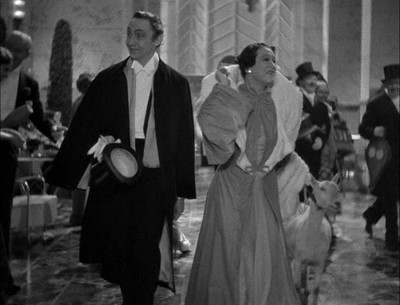
Half to spite her family and half because she's fascinated with his contempt for the rich, Irene hires Godfrey (a homeless man she's only met that evening, remember) to serve as the family butler, and from this thin thread hangs the plot. Godfrey turns out to be suspiciously good at butlering, delivering entire trays of martinis to Mr. Bullock with a speed and efficiency that made me want to start playing powerball.
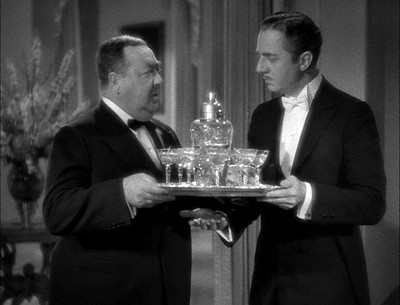
It's all very fun and funny and charming, and both William Powell's debonair charm and Carole Lombard's loopiness are in high gear. And althought Mischa Auer doesn't have a lot to do, the scene where he imitates a gorilla to cheer Irene up is one of the high points of American cinema. But although I love it, I have to confess that My Man Godfrey has always frustrated me. Next to Pretty In Pink, it's the most glaring example of a film where the wrong couple winds up together. Don't get me wrong: Carole Lombard is hilarious. But the chemistry between her and Godfrey is funny but not sexy. Gail Patrick, on the other hand...

She and Godfrey have such unbridled contempt for each other in the early scenes that I was expecting them to end up together, the way they would have in every other screwball comedy ever made. And the fact is, as sweet as Lombard is, she seems like Godfrey's little sister. Patrick is more interesting. There's more tension in the scene where she makes Godfrey polish her shoes than anywhere else in the film. Lombard's role, with its loopy exuberance and lack of any particularly deep characterization, feels to me like it wants to be a supporting character, comic relief the way Mr. Bullock or Carlo are.

I know it's bad form to criticize a film for not being a different movie that you'd like better. And the fact is, My Man Godfrey is exceptionally great. I just don't see the chemistry between Powell and Lombard (despite the fact that they were married before the film was done), and I do see it between Powell and Patrick. Powell, I think, is at his best when he's paired with someone who can throw his barbs right back at him (ideally, this would always be Myrna Loy, even if she had to wear a goatee). Irene is sweet and funny, but it's not clear why Godfrey would feel strongly one way or the other about her, and although it's clear what she wants, she's not enough of a force of nature for me to believe that she'd get it, at least from Godfrey.
But perhaps it's unfair to judge My Man Godfrey against the other great screwballs of its day. (It's certainly unfair to compare any other film to The Thin Man, which is incomparably wonderful.) In a real screwball, the two characters who loathe each other at the beginning should end up together, and always do. In My Man Godfrey, an impossibly patient and self-sacrificing servant teaches life lessons to a wealthy white family. In other words, in structure and theme, it's an all-white version of a Magical Negro film. Except it's excellent.
Randoms:
- Is there ever a bad time to remind you about Eugene Pallette's Apocalypse Ranch?
- I would love to know the story behind the blooper reel that's included on the DVD. There's no way the cutting room floor footage would have been kept by Universal, and even if it was, no one would have synched up the sound. Blooper reels apparently started as a studio-employee-only thing in the 1930s, so perhaps this footage was cut together for a cast party? In any event, if you want to see Lombard, Powell, and Pallette swearing like actual human beings, herre's your chance.
- Ted Tetzlaff's cinematography is remarkably fluid, craning up and down the swooping curves of the Bullock home's front stairs and moving gracefully forward and backward through the enormous rooms. I don't know if it's quite right to say that My Man Godfrey uses deep focus, as the lenses don't seem to be quite as good as in, say, Citizen Kane, but it's certainly blocked in deep space. Conversations are constantly happening between people on different planes.
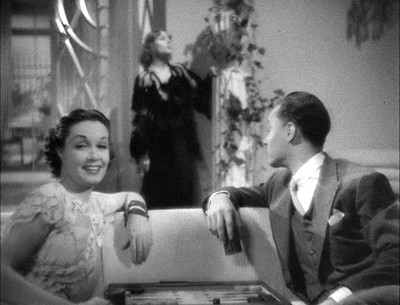
- And although it's not The Ipcress File, there are a surprising number of compositions with foreground objects drawing attention to the third dimension: martini glasses, flower arrangements, and lamps, lamps, lamps.
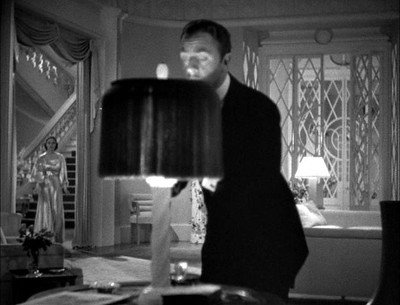
- So it wasn't a complete surprise to discover Tetzlaff used similar techniques to better effect in another film.

Wednesday, May 09, 2012
#113: Big Deal on Madonna Street
Big Deal on Madonna Street, 1958, directed by Mario Monicelli, screenplay by Agenore Incrocci, Furio Scarpelli, Suso Cecchi D'Amico, and Mario Monicelli, story by Agenore Incrocci and Furio Scarpelli.
In literature everyone understands the problems of translation. You only have to glance at a few sentences of Stuart Gilbert and Matthew Ward's respective versions of L’Étranger to understand how much of a mark the translator leaves on a text. New translations can be literary events in their own right. We understand, when it comes to books, that the original language is always preferable to any other version: a true literary polymath reads Milton in English, Tolstoy in Russian, Proust in French, and Shakespeare in Klingon. And yet, even though I'd wager that in an average year most English-speakers encounter many more non-English films than books, (with one major exception), film translation gets short shrift. It's not just neglect; there's a real difference in the way we think about language in films. I'm no exception—every word of German I know, I've learned from video games (Schnell, schnell! Die Amerikaner!). But when I say I've seen The Lives of Others, I mean it in a different way than when I say I've read Goethe.1 This isn't entirely irrational: film isn't quite so at the mercy of language as a Pynchon novel. But it's odd that film translation is so ignored: besides the occasional DVD package boasting that the subtitles have been "improved" (How? By who?), I don't know any cinephiles or critics who pay much attention to what's going on when a film is translated.
That's not to say no one pays attention. Studios care because they have to; at New Line I got to see the post-production department prepare a sort of annotated version of each film for use by translators. This consisted of a large binder in which every line of dialogue was dutifully transcribed, and any idiomatic expression explained within an inch of its life.2 It's easy to imagine when watching a foreign film that, assuming the translators were working from a sufficiently detailed binder, the English subtitles provide a functionally identical experience. And for, say, The Raid: Redemption, this might actually be true. But flip the problem around and this position immediately seems absurd. If you were writing Italian dialogue for Transformers, maybe you could pull it off. But what happens if you end up translating Fargo? You might be able to go through the script, line by line, and capture the literal meaning of each sentence. But half the point of the dialogue is the strange Minnesota diction ("a no-rough-stuff-type deal," or this exchange). There's no Italian sentence that conveys exactly the same meaning as "So I says, 'Well, that don't sound like too good a deal for him, then.'" And that's before you add the problem of accents. In the actual event, the Italian translators for Fargo seem to have ignored the accents and regionalisms completely: compare this to this. How much of the feeling of the scene is lost simply because Jerry Lundegard's Minnesota "Yah" is reduced to "Si?" I don't think there's a way to translate the experience a native English speaker has while watching Fargo into any other language. At least, not without taking an approach like Nabokov's translation of Eugene Onegin:
I had to decide between rhyme and reason—and I chose reason. My only ambition has been to provide a crib, a pony, an absolutely literal translation of the thing, with copious and pedantic notes whose bulk far exceeds the text of the poem. Only a paraphrase "reads well"; my translation does not; it is honest and clumsy, ponderous and slavishly faithful.
Which is basically the experience you'd have if the subtitles showed everything in the studio translation binders. But as much as I'd like to watch, say, the Nabokovian subtitle edition of Harold and Kumar Go To White Castle, I'm not sure it would be a big hit in movie theaters.
All of this is an roundabout way of saying that Mario Monicelli's Big Deal on Madonna Street is a very different film for a native speaker of Italian than it is for an English speaker. Before someone shows up in the comments to play Nabokov to my Edmund Wilson, let me be clear: I am not that native speaker of Italian. But I know there's a lot of information about the speaker's class and upbringing encoded in "Avvocà, io bisogna che esco—che esco subbitu!" that's not present in "Counselor, I gotta get outta here, now." And I'm afraid I don't see any reasonable way to communicate all of the meaning of the dialogue to viewers who speak other languages.
Which is not to say that Big Deal On Madonna Street should be the stone under which the whole rotten edifice of film translation crumbles. For one thing, I would hesitate to hang too much of a case for anything on a movie this light. It's not as if there are that many crucial subtleties or lost emotional resonances in the dialogue; the film opens with a completely bolluxed theft of a Fiat 1400 and ends with a meticulously choreographed heist that yields only a pot of leftover pasta e ceci. Nevertheless, virtually every character is a distinct Italian regional stereotype, from Memmo Caruteno's wildly gesturing Roman:
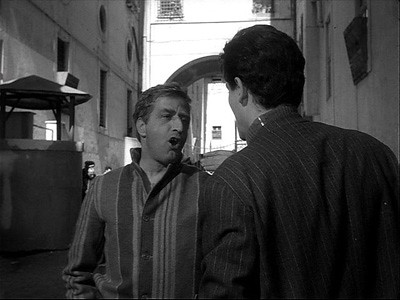
To Tiberio Murgia's Sicilian peacock.
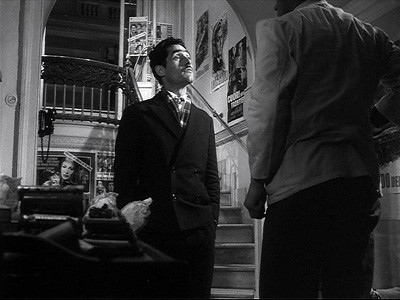
To Carlo Pisacane's whatever-the-hell-he's-supposed-to-be. He speaks Emilian and is always nibbling on any food he can get his hands on, but I've never heard that Emilians were stereotypically associated with gurning contests.
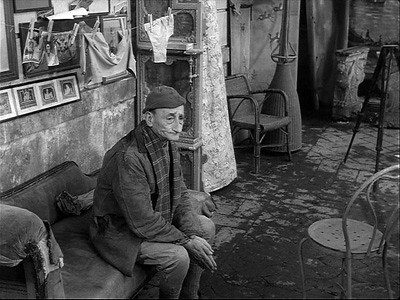
But in a film in which a great deal of an Italian audience's enjoyment comes from Boss-Hogg-level regional caricatures, the only part which makes it to the subtitles is a single line, the Sicilian's belief that the Abruzzese are citified northerners. Non-Italian speakers will probably notice that one character's attempt at a northern Italian accent is terrible, simply because his voice suddenly sounds cartoonish. But again, that's not in the subtitles; that entire level of meaning just doesn't make it to English.
Which is not to say that there's not a lot to enjoy, no matter what language you speak. Big Deal on Madonna Street, even without the accents, is one of the funniest heist spoofs ever made, and its success on this level is entirely translatable. The plots of these sorts of films are all more or less interchangeable: learn about the big score, build a team, planning, execution, MISADVENTURE. Usually, you're hoping for exceptionally charming or interesting people to make up the team—and Big Deal On Madonna Street has that in spades. But if you or I made a heist spoof with the same actors playing the same characters, it would probably not be as funny. Part of the reason it's as good as it is is that Gianni Di Venanzo's cinematography plays it completely straight. You'll have a hard time finding a better looking noir than this.

That's Tiberio Murgia again on the far right; the others are Rossana Rory, Renato Salvatori, and yes, Marcello Mastroianni. They're attending a boxing match that perfectly illustrates the way the film works: the boxers leave their corners in a shot that's as inky as the opening of The Big Combo, complete with Scorsese-style flashbulbs.
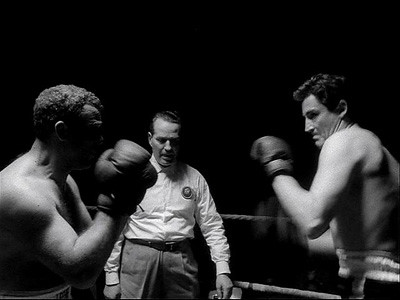
The mood lasts for less than two seconds before Vittorio Gassman takes a punch to the face and goes down crosseyed like Chaplin.
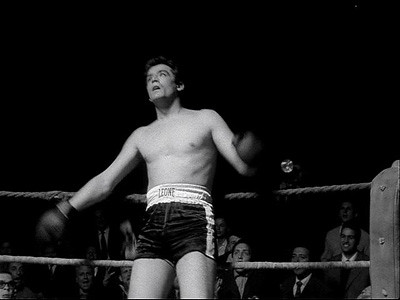
That's Big Deal On Madonna Street in a nutshell: very serious cinematography in service of very silly jokes. Mario Monicelli's second secret weapon is Rome circa 1958, which lends a certain gravitas to the proceedings by virtue of being unrelentingly depressing.
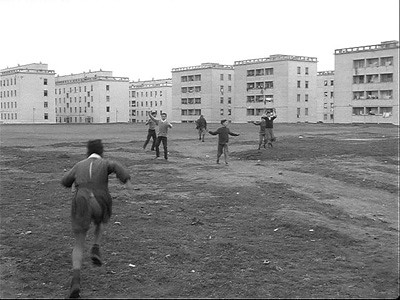
It isn't neorealism, but it lives in the same crappy neighborhood.
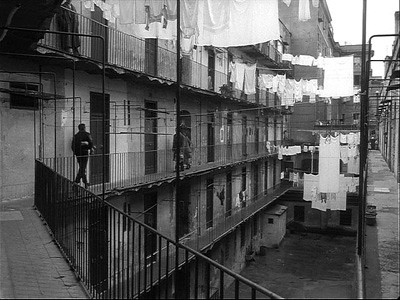
The exceedingly low ambitions of the hapless burglars at the film's center fit right in with the locations. As far as the team goes, Marcello Mastroianni is the standout, as a photojournalist who's fallen on hard times and had to sell his camera. His wife's in prison for smuggling cigarettes, which means he's planning a criminal conspiracy while babysitting.

The rest of the gang puts him in charge of shooting surveillance footage of the pawn shop they're planning on robbing, and the film is worth seeing solely for Mastroianni's boyish enthusiasm at the blurry, juddery footage he proudly screens for them. At least half of it is "test shots" of his kid.

There's also a nice part for Totò, who is something of a minor diety to Italians.3 He's not on-screen much—although he got largest billing on the original Italian posters—but he does the right kind of celebrity cameo (cf. Keaton in Sunset Blvd.), not drawing too much attention to himself or stealing scenes. He just puts as much realism as possible into the part of a master safecracker whose set of tools includes a cheese grater.

The film also offers the opportunity to see both Carla Gravina and Claudia Cardinale at the very start of their careers. Cardinale, playing the sister the Sicilian is keeping locked up before her wedding, is all of 20 years old. You can probably see exactly where this particular plot thread will go:

Gravina was still younger; she couldn't have been more than 16 during filming. She gets to do a sort of live-action version of "American Girl in Italy."

It's a great cast, and they're what sell the movie, because the outcome of Big Deal on Madonna Street is never in much doubt. As in any heist film, things will go wrong, the gang will splinter, and by the end, no one's lot will be much improved. Those are the demands of the genre. But the charm of Big Deal On Madonna Street is that success or failure doesn't seem to matter all that much to the characters. They go through the motions of a heist, but you wouldn't call them criminals, exactly. It's more accurate to say that they're always, always working an angle, the more improbable the better. And when their schemes fail, as they inevitably do, they're basically content, because what're you gonna do? Like I said: some kinds of Italian, they don't make subtitles for.
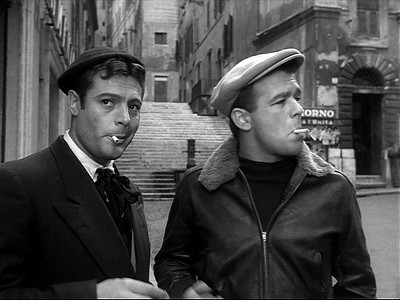
Randoms:
- Many of the actors are dubbed by other actors who spoke the appropriate dialects. Tiberio Murgia was Sardinian, not Sicilian, and ended up being dubbed by a Neapolitan. Carlo Pisacane, who actually was Neapolitan, was dubbed by a Friulian in Emilian. Memmo Carotenuto speaking his own Romanesco was the exception, not the rule. But by far the oddest bit of dubbing was Rossana Rory, who was dubbed by Monica Vitti. Yes, that Monica Vitti.
- The film's plot follows Rififi closely enough that the working title was apparently Rufufu.
- Through a complicated sequence of events, Totò managed to be the heir to two noble families and all their inheritable titles. Which means his full name was, honest to God, "Antonio Griffo Focas Flavio Ducas Komnenos Gagliardi de Curtis of Byzantium, His Imperial Highness, Palatine Count, Knight of the Holy Roman Empire, Exarch of Ravenna, Duke of Macedonia and Illyria, Prince of Constantinople, Cilicia, Thessaly, Pontus, Moldavia, Dardania, Peloponnesus, Count of Cyprus and Epirus, Count and Duke of Drivasto and Durazzo." Gods, stand up for bastards!
1For one thing, when I say I've seen The Lives of Others, I'm not lying.
2"The Gift was a film directed by Sam Raimi in 2000. Katie Holmes is an actress who appeared in The Gift. "Titties" is a colloquialism...
3Chaplin may be the Chaplin of the Zulus, but Totò is, now and always, the Chaplin of the Italians.
Thursday, March 15, 2012
#112: Play Time
Play Time, 1967, directed by Jacques Tati, written by Jacques Lagrange & Jacques Tati, with additional English dialogue by Art Buchwald.
One of my college professors summed up James Joyce's career by saying that Joyce mastered the short story, the novella, and the novel, in that order. Then, with no more worlds to conquer, he moved on to something else. And yet, despite that fact that it more or less invents its own art form, just about any passage chosen at random from Finnegans Wake is immediately recognizeable as Joyce. Play Time, Jacques Tati's marvelous film about modernity and its discontents, is Tati's "something else," a film that invents its own genre and visual language, yet is clearly the descendant of M. Hulot's Holiday and Mon Oncle. It is an essential film, an unimpeachable masterpiece, and you should see it immediately. If you've already seen it, see it again.
And as much as I love the Criterion Collection (and their Blu-Ray release is as good as you could hope for) you should find a way to see this film in a theater. There's a 70mm print that's been touring; track it down. Because I'm not kidding about Tati inventing his own visual language, and it is not well-suited for televisions (or, God forbid, telephones). Take a look at this shot, which is not atypical (clicking on the image will take you to a larger—but still much too small—version):
If you squint, you can almost make out M. Hulot shaking hands in the center of the frame. Obviously that sort of composition is going to look better on film than on TV, but it's not just because of the occasional long shot that I recommend first encountering this in a theater. Play Time was shot and edited in a style that I don't think I've ever seen before, which I would provisionally call "whatever the opposite of intensified continuity is." There are no close-ups at all, and hardly any medium shots. Hulot shaking hands is actually one of the easiest to read shots in the film, because there's nothing else going on in frame; this is rarely the case. In terms of visual information per square inch, most films are Pop Art. Play Time is the Raphael Rooms.
There's nothing in the image above directing your eyes anywhere, and there's detail everywhere. There are frames that crowded in lots of movies; I saw one over the weekend during the masquerade ball sequence in The Emperor's Candlesticks, of all things. But it was an establishing shot of the ball, probably less than three seconds long, and, most importantly nothing happened. The shot above lasts for twenty-one seconds, and over the course of that time, the following things happen, more or less simultaneously:
- In the foreground, a waiter crosses from left to right, attempting to deliver a platter of fish to the table in the lower right, but they don't seem to have ordered it.
- The red haired woman in the white dress can't... stop... doing the monkey.
- Another waiter, carrying an identical fish platter, crosses from right to left, stopping at the center front table to ask if they ordered it, but also asking random people on the dance floor. He nearly drops the fish when an American dancing with his wife bumps into the platter (you can see this happening in the still), but pulls it back in place by the tail.
- That same American, more or less dragging his wife across the dance floor, bawls out the waiter for trying to carry fish through the crowd, before dancing off to the right...
- ...which is too bad for his wife, who seems to be the one person who ordered the fish, because when she sees it she reaches out towards it and tries to get the waiter's attention, to no avail.
- The maître d' (the balding man in the tuxedo in the center of the still) works his way though the crowd and attempts to direct the two waiters with the fish...
- ...Which puts him directly in the path of the elderly waiter crossing from right to left with the tray of what look like rolls. With no way around him, the waiter basically pushes the maître d' offscreen to the left, using his tray to guide him.
- And that's just the foreground, because in the background, another waiter with the same goddamned fish platter attempts to deliver it to the band onstage before being waved off.
- And way in the back, a workman meanders onstage with a coil of cable he's running (the restaurant is still under construction), before being directed offstage.
All that happens in twenty-one seconds. Play Time is two hours, three minutes, and three seconds long. And maybe the fifth or sixth time you watch it, you'll notice that the workman in the background is played by Tati himself. This is why Gilbert Adair famously said that Play Time demanded repeat viewings from different seats in the theater. The idea behind virtually all film grammar is to direct the audience's attention towards whatever is most important in the frame. Tati isn't interested in this at all. In Play Time, as he told Jonathan Rosenbaum, his goal was to create "a democracy of gags," conflating the difference between foreground and background, main characters and extras. Anyone on screen can be doing something funny, at any time. Which, let's be honest, makes Play Time sound exhausting. But it isn't at all; it's glorious. For one thing, the shot above is late in the movie, towards the end of a long sequence in which the on screen energy is slowly and precisely ramped up. And Play Time, like most masterpieces, begins by teaching us how to watch it. Not counting the opening credits, here are the first three shots. The opening titles appear over a background of fluffy clouds, which are more or less wiped out by what I guess you'd have to call an establishing shot:
Next, we get a single-gag shot that basically serves as a reassurance that we're still in a Jacques Tati film.
As the two nuns walk down the hallway, their wimples flap like birds in flight. This is a joke that would be perfectly at home in M. Hulot's Holiday, and notice how simply it's staged: the nuns move from top left to bottom right; the hallway they're walking along is the only plane of action in the shot. Most importantly, there's only one joke on screen. This is intensified continuity: you know exactly where the director wants you to look, and if you hear anyone else in the theater laughing, you can be sure you're laughing at the same thing. And now we arrive at the shot where Tati throws intensified continuity out the window.
We track the nuns from the earlier shot as they enter from the left, make a ninety degree turn, walk away from the camera, then turn right and exit through the middle hallway on the right. The camera will stay completely still on this scene for the duration of the shot, one minute and forty seconds. There are three planes of entry on the left and four on the right, and Tati uses them all. But he starts off easy. The minute the nuns leave the frame (but not before) another character enters from the closest hallway on the right. Once he leaves (but again, not before), another character, another depth. We can trace their geometric paths up and down the hallway, or we can watch the bickering couple in the foreground; the camera isn't giving us any cues. Eventually, Tati has more than one person moving down the hallway at a once; a military officer, a short man with a coat thrown over his shoulders, a woman with a stroller.
The shot trains the viewer's eye to move freely around the frame, from the couple in the foreground to the women standing by the distant window. Tati isn't going to give us the kind of cues we expect from filmmakers. The effect, intentionally, is to make you watch the film the way you would watch passersby if you were really in that waiting area. By the time Tati finally cuts to a reverse shot, you can take your pick:
There's action on each of the three horizontal planes defined by the hallways. You can watch the man with the violin case, the military officer, the man with the towel wrapped around his head, or a man who appears to be M. Hulot, but if we look closely, is not. In fact, the film's opening scenes are filled with Hulot's dopplegangers; close enough to the real thing that an onscreen character spots Hulot's distinctive walk and stops him. Whereupon he turns.
Not only is he not Hulot, he's annoyed to have been mistaken for him. Hulot will be in this film, but he's not going to be the star. In fact, the genuine article doesn't appear until nearly ten minutes into the movie, trying to get off a bus with his umbrella entangled with that of one of his doubles.
So: no intensified continuity, no main character, long takes with nothing guiding the viewer's eye, but what is the film about, for God's sake? It has less of a plot than M. Hulot's Holiday (itself not a particularly plot-heavy film), but there are a few through-lines. Although dozens of characters appear and reappear throughout the film, Tati favors two: M. Hulot, in town to attend some sort of business meeting (perhaps the one he's sent off to at the end of Mon Oncle), and an American tourist, played by Barbara Dennek, visiting Paris. Where Mon Oncle showed a battle between old and new France, Play Time is set in a city where, to put it bluntly, the bums lost.
There's a great running joke where Barbara keeps catching glimpses of Parisian landmarks in the reflections of doors before getting herded back onto her tour bus and dragged off to some new glass monstrousity, but my favorite thing in the film are the posters in the travel agency she visits. (I would pay a great deal for a set of replicas, in fact). Click the image to get a good look at them:
Barbara does find one oasis of the Paris she came to see (and photograph), and here it is.
Hulot, in the meantime, utterly fails to keep his business appointment, tracking the man he's supposed to meet with through a warren of cubicles with his usual unflappable grace.
As with his earlier films, the plots exist only to bring the characters from one location to another. But unlike the lazy, wandering charm of M. Hulot's Holiday or Mon Oncle, Play Time actually does have a rigid structure. The odd, and I think unique thing, is that it is organized by theme rather than incident. Philip Kemp summarizes the plot as "how the curve comes to reassert itself over the straight line," and that's quite accurate. The opening sequences are all about people moving in rigid straight lines; living within the boundaries that modernity has laid out for them.
Hulot gets himself into trouble, but he doesn't manage to cause any real chaos the way he did in Mon Oncle. In the earlier film, Hulot posed a genuine threat to the Arpels' bourgeois respectability, but you get the sense that the architecture in Play Time is designed to absorb any resistence Hulot could possibly mount. Tati doesn't just allude to the way the inhuman scale of these buildings grinds the human soul to dust, he makes the audience experience it, too. Witness the excruciatingly long take of Hulot's business associate coming down the hallway to meet him.
The shot is one minute and fifteen seconds long, and a full forty seconds are spent waiting, with Hulot, for the man to walk down the entire length of the hallway. When he finally reaches us and we're expecting, at long last, something to happen, the man sizes Hulot up... and ushers him into a waiting room. It's like a Frederick Wiseman documentary about Camazotz.
One could imagine Lars von Trier producing a version of Play Time in which no one breaks free of their shackles, but Tati is an eternal optimist. So after about an hour of people failing to beat the system, both Hulot and Barbara end up at a restaurant called the Royal Garden, opening for its first night of business. It is just as hostile to human interaction as anything else in the film:
As in Mon Oncle and the first half of Play Time, humanity and architecture do battle, but this time architecture loses. This is, I think, one of the most perfect sequences in all of cinema. The editing and pacing are superb; Tati lets things build up so slowly you don't realize how manic it's gotten until you really pay attention to everything that's happening in a single shot. The first half of the film has several one-minute shots that seem to last about about an hour (on purpose!); the Royal Garden sequence is fifty minutes that feel like five. Eventually, Barbara, Hulot, and some of the other characters from the first half of the room manage to create something like a Parisian café in the wreckage of the restaurant; a smaller space for genuine human interaction.
When they finally emerge from the restaurant the next morning, the world is transformed around them. In Mon Oncle the lines of identical cars were a sign of conformity, but in Play Time Tati transforms them into a merry-go-round.
It's only at this point that Tati returns the colors that seemed to have been leached out of everything that's come before. The older world Hulot inhabits in the earlier films may not be coming back, but all is not necessarily lost. Play Time suggests there is human beauty in even the most austere modernist spaces. But we're going to have to fight for it.
Randoms
- Unfortunately, (and again, like Finnegans Wake), the production of Play Time was a multi-year debacle. Filming took nearly three years, the budget was spent many times over, Tati was financially ruined, and in the end, it was released to indifferent critical response and didn't even get distribution in the United States. Tati seems to have been fairly equanimous about the relationship between financial and artistic success, however. At a Q&A after the film's 1972 U.S. premiere at the San Francisco International Film Festival, someone asked him, "How much did it cost to make Play Time and how was it received in Europe, artistically?" (I love the tacked-on second part of the question). His answer, even in less-than-perfect English, is definitive:
Well, first, I will give you the address of the people who finance the picture—I came here on the artistic point of view, I didn't come on the business point of view. The only thing I can tell you, that I had a house before Play Time, I don't have my house today. So you can understand what kind of balance is between the picture, the finished picture. But I don't think it's very important. Or—that's what I feel, you asked me a question—or you have the respect of the young generation in my age—that's what I think I have, I've seen it here—or you have the respect of the Banque de France. It's a choice.
- Nothing in this essay shoud be construed to imply that any redeeming vestiges of humanity will ever be found in Government Center. Let's not kid ourselves.
- Except for Paris-Orly Airport, all of the locations were built for the film; an entire city block as well as several miniatures for forced perspective shots. One of the original plans to finance Play Time was to build actual office buildings instead of sets, and sell them after production was finished; that didn't work out, and the entire set was destroyed shortly after production. You can get a good look at two of the miniatures in Cours du Soir, a short film partially shot on the set of Play Time. There's a wonderful shot of buildings parting like the Red Sea for Hulot to pass on his way to a run-down shack.
